We’ve all been the recipient of a poorly targeted sponsored Facebook ad. In fact, I was recently the target of such poor marketing when this post popped up in my News Feed. →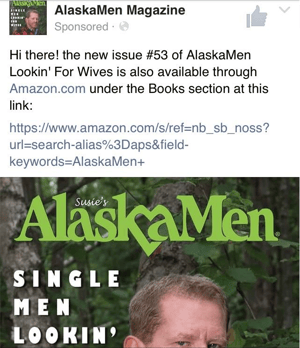
Not only have I lived in Florida my entire life, but I am also recently married. Both of these factors are clearly represented in my Facebook profile, and thus should have excluded me from this particular advertisement.
Just another case of poor buyer persona segmentation.
Clearly, it’s easy to miss the mark on targeting your Facebook audience. But with proper research and testing, you can segment buyer personas and cut cost per click like a pro. Here’s how we did just that for our client in the water treatment industry.
The Client
This client provides state-of-the-art water treatment systems for homeowners across the state of Florida. Their flagship product – a simple-to-maintain, complete home water filtration system – creates refined, clean and soft water for years to come.
 Research and get to know your client and its services and/or products thoroughly before spending precious ad dollars. This will help you identify the pain points its offerings solve, so you can more clearly identify potentially interested audiences in the next step.
Research and get to know your client and its services and/or products thoroughly before spending precious ad dollars. This will help you identify the pain points its offerings solve, so you can more clearly identify potentially interested audiences in the next step.
The Buyer
Before creating our campaign, we identified and created a primary buyer persona for the client and its products so that we could better target its ideal customers with content and advertising. The primary and secondary buyer personas we developed: mothers of young children and their husbands.
Example Buyer Persona
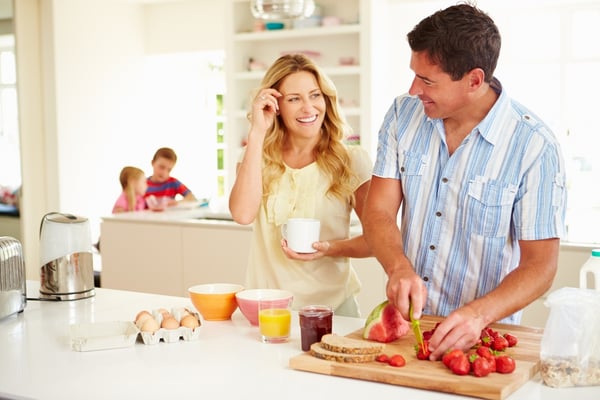 Julia is a mother to two beautiful young children with her husband Mike. They have a combined household income of $80,000 and are in their mid-thirties. Julia has recently noticed some water-related issues around the house: chlorine or sulfur tasting water, hard water stains on glassware, fading colors on clothes and her dyed hair, and an increase in soap use (hand soap, laundry detergent, dishwasher detergent, shampoo, etc.). She knows Florida’s water has a bit of a bad reputation in water quality and is looking for an affordable solution to implement across her entire home.
Julia is a mother to two beautiful young children with her husband Mike. They have a combined household income of $80,000 and are in their mid-thirties. Julia has recently noticed some water-related issues around the house: chlorine or sulfur tasting water, hard water stains on glassware, fading colors on clothes and her dyed hair, and an increase in soap use (hand soap, laundry detergent, dishwasher detergent, shampoo, etc.). She knows Florida’s water has a bit of a bad reputation in water quality and is looking for an affordable solution to implement across her entire home.
Mike might not see the same concerns Julia is noticing, but he definitely wants to keep his wife happy. While Julia is the main decision maker and advocate for finding a solution, Mike wouldn’t be too happy if he was left out of the process. Plus, if the solution can help them save money in the long run (on plumbing, appliance repairs, clothes, soap and hair treatments), he is all for making a change.
 Similar to Pro Tip #1, research and get to know your client’s customers thoroughly before spending money on advertising. When choosing demographics and interests, you can easily imagine which options would best fit the buyer persona.
Similar to Pro Tip #1, research and get to know your client’s customers thoroughly before spending money on advertising. When choosing demographics and interests, you can easily imagine which options would best fit the buyer persona.
The Offer
To convert website visitors coming from social advertising into qualified leads, we created a landing page with a product-relevant offer – a free in-home water quality test with complimentary retail store gift card. This page would serve as our landing page after a user clicked on an advertisement.
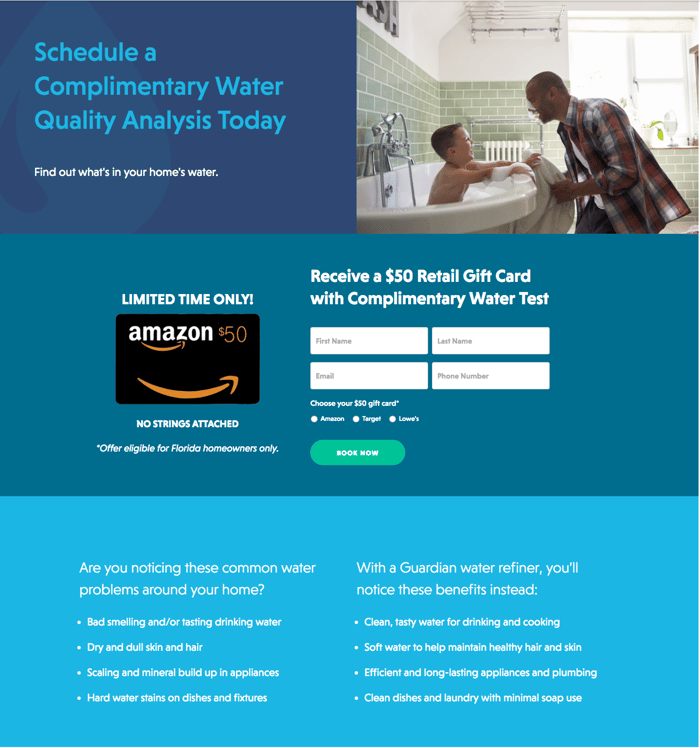
 The offer landing page is crucial to the overall success of your campaign. Include a strong visual to entice the visitor, as well as clear directions for filling out the form. Ensure the page is optimized for mobile, especially since you’ll be advertising on Facebook.
The offer landing page is crucial to the overall success of your campaign. Include a strong visual to entice the visitor, as well as clear directions for filling out the form. Ensure the page is optimized for mobile, especially since you’ll be advertising on Facebook.
The Campaign
We split our Facebook advertising budget into three segments to test and optimize different factors that would drive cost per click (and ultimately cost per lead) down.
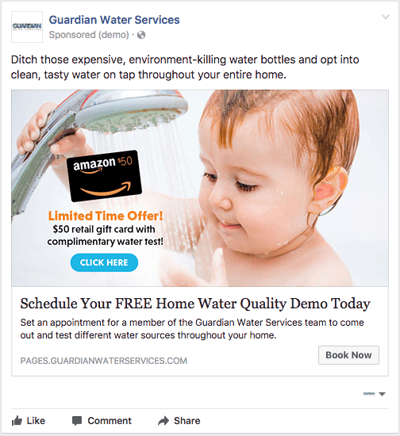 ROUND #1 – Optimizing for Gender, Creative and Placement
ROUND #1 – Optimizing for Gender, Creative and Placement
With our first round of ads we cast a broad net to collect data on who would respond best to our offer. This means we targeted male and female Facebook users on desktop and mobile devices using two different creatives. By creating unique tracking URLs in HubSpot for each segment (for example, female + mobile + creative A), we could compare Facebook link clicks to landing page views (and ultimately converted leads) for each segment.
From this data, we were able to determine female mobile users responded best to creative A. Now we needed to fine tune the age ranges and targeted interests.
 Never underestimate the power of a good graphic designer! Professional and eye-catching images are a must for Facebook. Users are typically scrolling through their News Feed mindlessly, so investing in good images will be well worth the increased clicks.
Never underestimate the power of a good graphic designer! Professional and eye-catching images are a must for Facebook. Users are typically scrolling through their News Feed mindlessly, so investing in good images will be well worth the increased clicks.
ROUND #2 – Optimizing for Age and Interests
With our second round of ads we created five different segments based on age range that again each had their own unique tracking URL:
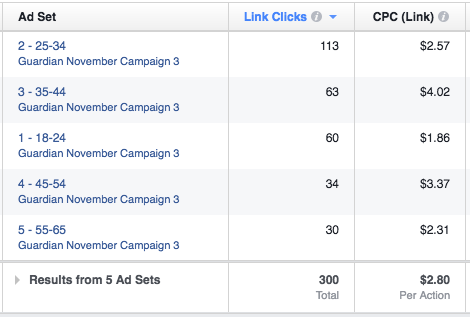
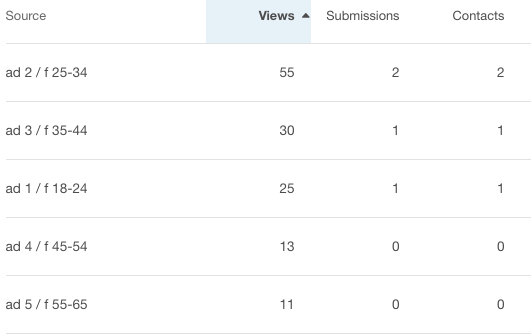
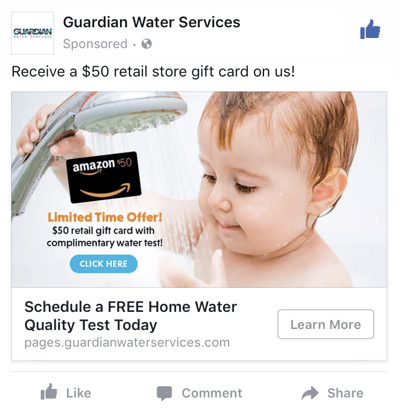 Based on link clicks and leads generated, we identified 18- to 44-year-olds as our top performing age group, though the 35- to 44-year-olds had the highest cost per click. Had we not used the HubSpot tracking URLs, we may have excluded this high-performing age group based strictly on cost. However, because our data revealed it had the second highest clicks, views and submissions, we kept it included in our targeting.
Based on link clicks and leads generated, we identified 18- to 44-year-olds as our top performing age group, though the 35- to 44-year-olds had the highest cost per click. Had we not used the HubSpot tracking URLs, we may have excluded this high-performing age group based strictly on cost. However, because our data revealed it had the second highest clicks, views and submissions, we kept it included in our targeting.
Our initial interest targeting included parenting publications and mommy blogs. To expand our audience reach, we included local public school systems and tutoring businesses in this second round of ads.
We also simplified the copy and changed the CTA from “Book Now” to “Learn More,” which is a more top-of-the-funnel, and thus more appropriate, CTA for driving social advertising traffic.
ROUND #3 – Optimizing for Lowest CPC and CPL
With our third round of ads we focused our age range on 18- to 44-year-old females on mobile devices with creative A. Because we were not testing any other factors, we created only one ad that was able to optimize organically based on engagement, shares and clicks.
By putting the entire remaining budget to this one best performing ad set, we drove the cost per click down 23% and saw a 125% increase in leads over the second round of ads.
 Once you find your sweet spot in segmenting buyer personas, put the majority of your budget toward the one ad. Facebook will automatically optimize your ad over time.
Once you find your sweet spot in segmenting buyer personas, put the majority of your budget toward the one ad. Facebook will automatically optimize your ad over time.
The Results
By further segmenting our buyer personas by gender, creative, placement, age and interests, we were able to decrease our cost per click by 30% and ultimately our cost per lead by 90%.

The Lesson Learned
While the goal of running social advertising is to get traffic to a landing page at the lowest cost possible, we also want to make sure that traffic will provide qualified marketing and sales leads for our clients. It became clear over the course of running these ads that although the 18- to 24-year-olds had the lowest cost per click, they did not convert into customers as well as the older age groups. This is where, as a marketer, we must listen to common sense above our advertising data. When it comes to the metrics that matter, quality is almost always better than quantity.
January 11, 2017

